Fighting Soviet landing in the rear of the enemy during the war
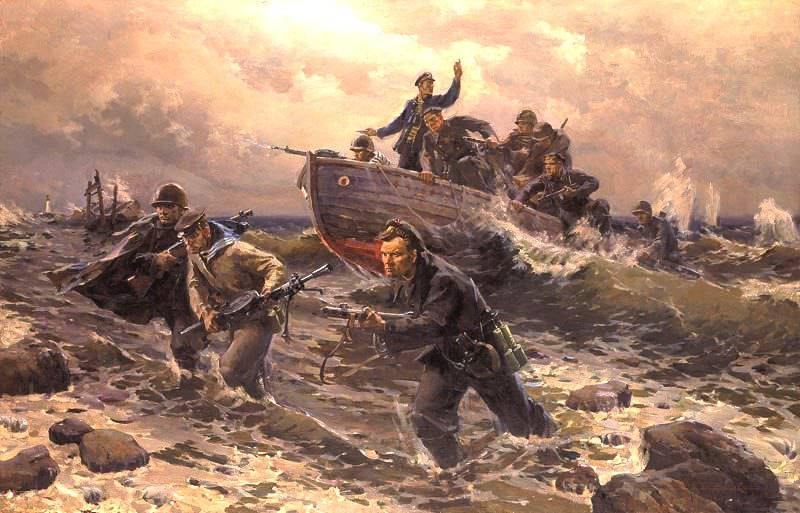
Our prewar statutes and instructions provided for the wide use of airborne and maritime assault forces. Airborne troops were considered a means of high command and were designed to solve operational-tactical tasks in the rear of the enemy, as well as to achieve continuous impact on the depth of his defense. This provision was in the Provisional Field Regulations of the Red Army 1936 of the Year, the Field Statutes of 1940 of the Year, the Statute on the Airborne Forces of 1941 of the Year, and in a number of works by prominent Soviet military commanders and military scientists.
By the beginning of World War II in the Soviet Union, the formation of five airborne corps (from the 1st to the 5th), with more than 10000 people each, had begun. Each corps had a three-brigade composition, and, in addition, it included a separate armored battalion (out of fifty tanks) and company communications.
By mid-1941, a sufficient number of airborne formations had been created, which could conduct military operations behind enemy lines, however, the military transport available aviation could not ensure the massive use of the landing due to the lack of means of landing.
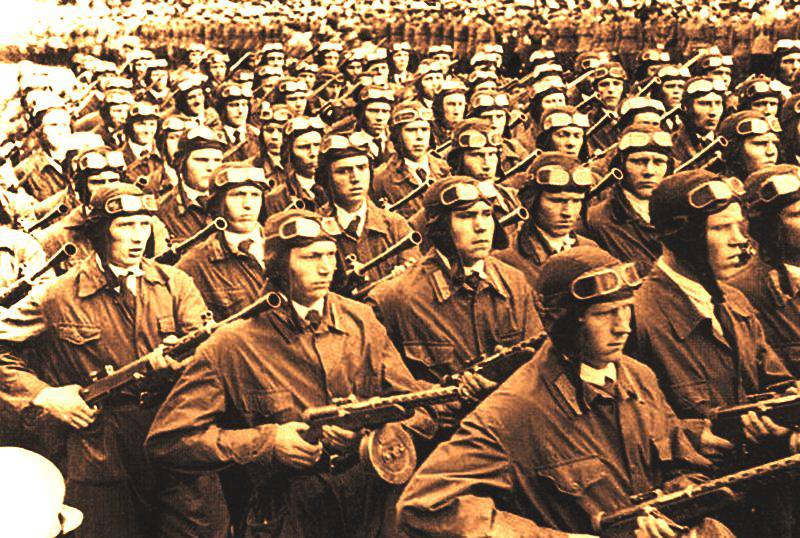
Landing of strategic, operational and tactical landings from naval directions was provided for in most official documents regulating the military activities of the Navy, as well as theoretical works of those times. However, the Russian fleet did not have marine corps at that time, so it was recommended to use conventional rifle units as naval landings. Were absent in navy and specialized landing craft.
The outbreak of the Patriotic War did not allow for the full implementation of the planned measures for the reorganization of the airborne troops, the creation of the marines, and the provision of them with the necessary combat equipment and landing gear. All these tasks had to be solved already in wartime.
Airborne troops stationed in the Baltic States (5 airborne corps), Belarus (4 VDK) and Ukraine (3 VDK) met the war in the stage of formation, coalescence of controls, and because of the situation on the fronts were forced to fight as usual rifle connections. And only by November 1941, the 4 and 5, the VDK, began to be withdrawn from the active army to the rear of the country for re-staffing. At the direction of the State Defense Committee, as early as August 1941, the tasks solved by the airborne troops, their organizational structure, the order of aviation, as well as logistics, were clarified; The Military Council of the Airborne Forces was created, headed by the Commander of the Airborne Forces, Major General V.A. Glazunov.
Simultaneously with the formation of five new airborne corps (1941-6) at the beginning of autumn 10, 10-ti of separate air transport squadrons and 5-ti separate squadrons were deployed. Later, in the 1942 year, these aircraft units were reduced to four air transport regiments and equipped with the U-2, P-5, TB-3, PS-84 aircraft. These activities enabled the High Command at the end of 1941 - the beginning of 1942, to successfully launch several airborne assault forces into the German rear. Airborne assault forces during the Battle of Moscow, the defense of Odessa and the Crimea found widespread use. Their main task was to assist the troops leading the offensive from the front in destroying the main enemy groups using strikes from the rear on his defense, as well as capturing and holding automobile and railway junctions, destroying military command and control centers and obstructing the supply of enemy troops.
The composition of the air assault forces had a wide range; from several dozen fighters (Chebank, Ak-Monai, Crimea) to several thousand (operation south of Vyazma). The basis of weapons paratroopers was small weapon, as well as mortars and mine explosives. The depth of the landing of assault forces also varied greatly and reached 150 km, and in some cases even more.
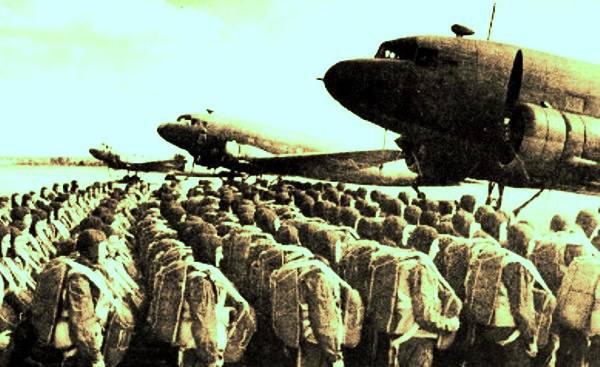
An important role in the counteroffensive near Moscow, in particular, in the defeat of the German Klin grouping by the forces of the 30 Army, was played by an airborne assault force ejected in the Teryaev Sloboda area in December 1941. During the ten days of hostilities in the fascist rear, paratroopers blew up 29 bridges, destroyed about 50 tanks and vehicles and more than 400 enemy soldiers.
The airborne troops (2 battalion 201 vdbr) of captain I.A. Surzhik, thrown out at night 18 January 1942, under Znamenka (southeast of Vyazma). Having mastered several platforms suitable for landing, he provided the landing assault, in the role of which was the 250 Infantry Regiment, together with which he captured and held for ten days important road junctions in the rear of the German Yukhnovskaya group, thereby contributing to the successful exit of 1- Guards Cavalry Corps to Vyazma.
Airborne Lieutenant P.L. Belotserkovsky (4 battalion 204 vdbr) at the beginning of 1942 in the Okorokovo area (west of Rzhev) assisted the troops of the 29 army, leaving the encirclement. To support and assist the troops of the Kalinin and Western fronts in the defeat of the German Rzhev-Vyazma group at the beginning of 1942, it was planned to parachute 4 airborne corps (8, 9 and 214 vdbr) in the area of Izdeshkovo, Ozerechnya (to the west of Vyazma), Colonel (27.01.1942, 02.02.1942 and 8). . Kazankina. However, due to errors in dropping the first airborne detachment, the unsatisfactory air cover of the landing area during the week (1-XNUMX), only two XNUMX IDF battalions parachuted, which went into action with the XNUMX-GW cavalrymen. kav corps and partisans.
10 February 1942 of the year 4 VDK received a new task - to parachute near Yukhnov, make a breakthrough of the German defense with a blow from the rear and unite in the Klyuchey area with the 50 army, and participate in the further defeat of the Yukhnovo group.
After dropping into the Zhelanie area, Petrishchevo during February 18-23, the corps struck the enemy with a series of strikes from the rear and went out to the Klyuche area. However, the enemy, repelling the attacks of the 50 Army from the front, forced the paratroopers from March 1 to go on the defensive, and subsequently to reconnaissance and sabotage actions. Combined in May with parts of the cavalry corps, the landing corps made an almost 200-kilometer raid in the rear, and, breaking through the defenses of the Nazis with a rear strike north of Kirov, during the 24-28 of June came with serious losses to the 10-th army.
In general, the airborne assault forces operating in the Kalininsky and Western fronts in the 1942 year caused some losses to the fascists, chained them, not allowing them to transfer individual units to another direction. The airborne assault forces actively used the offensive, the breakthrough of enemy defensive lines, defended both individual objects and fairly vast territories, carried out raids, laid ambushes and sabotage. The most important task of their combat activities were raids on enemy rear areas (8 vdbr in February and 4 vdk in June). However, it is worth noting that the effectiveness of the paratroopers' combat operations was significantly reduced due to the limited means of landing, inadequate equipment of the assault forces with artillery systems and anti-tank weapons, problems in ensuring high-quality interaction with ground forces leading the offensive from the front, not always satisfactory aviation support, providing the necessary material means.
The use of amphibious assault forces in most cases was determined by the tasks of the ground forces that operated on the coastal directions. In October 1941 of the year, the State Defense Committee issued a decree on the establishment of naval infantry brigades in the 25 fleets. For these purposes, the Navy Commissariat allocated almost 38000 people. These brigades later formed the backbone of most amphibious assault forces.
The following facts speak about the expediency of using naval assault forces in the interests of the ground forces. In July 1941 and April 1942 of the year, the Northern Fleet landed four tactical amphibious assault forces from the battalion to the navy brigade on the Nazi-occupied coast, which, having struck a series of sudden strikes on the flank of the 20 German army on the Karelian front to thwart the enemy’s plans for mastering Murmansk.
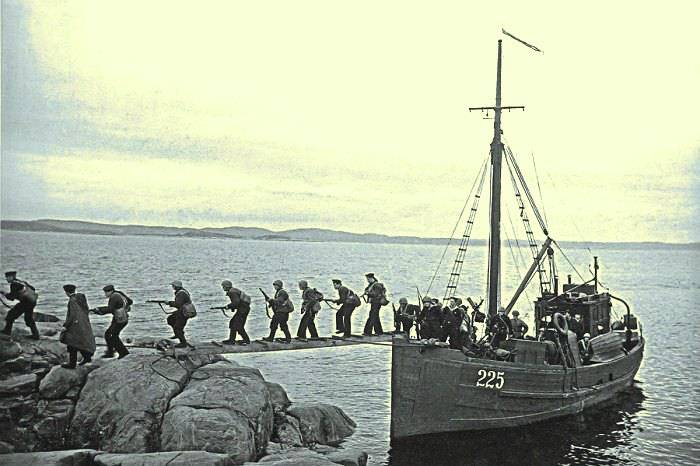
You can also note the successful actions of naval landings in the period of the defense of Leningrad, Odessa and Crimea, which used offensive, defense, raids, sabotage. At the same time, their most common action was the seizure of a section of the coast by a swift strike, and then the retention of it, which had the goal of stifling significant enemy forces. The disadvantages of amphibious assault operations during this period include, first of all, the lack of amphibious assault ships of special construction, the limited nature of the tasks, insufficient provision of airborne assault landing, weak interaction with ground forces.
In general, the first period of the Patriotic War became a serious school for our Airborne Forces and the Marine Corps. It was a period of testing the basic theoretical positions on the conduct of hostilities in the enemy rear developed on the eve of the war, studying and summarizing the accumulated combat experience, improving weapons, military equipment and landing gear.
In the second period of the war there was a further development and improvement of military operations in the rear of the enemy. In preparation for the offensive operations of the 1943 of the year, the General Headquarters gave instructions to the commanders of the Airborne Forces on the intensive preparation of the formations for the fulfillment of the tasks of seizing bridgeheads on large water barriers (on the sea coast). In this connection, the actions of the 3 and 5 brigades, thrown out in the attack zone of the 40 Army of the Voronezh Front in September, 1943, to capture a bridgehead on the western bank of the Dnieper near Kanev, deserve attention. Despite significant shortcomings in landing (poor reconnaissance, poor navigation support of military transport aircraft, large dispersion of paratroopers, low accuracy of the drop and poor communication within the landing force and with the command of the army and the front), the landing force (especially 5 IDB) contributed to creating favorable conditions for defeat of the Chervassian-Kaniv grouping.
During the fighting in the German rear (from 25.09.1943 to 28.11.1943), units of the landing force west of the Dnieper destroyed more than 4000 Nazis, captured and destroyed a significant number of military equipment, warehouses and vehicles. In addition, they eliminated the concentration camp guards and freed about 500 prisoners of war, and also saved the lives of many hundreds of Soviet citizens hiding from invaders in the forests.
Successful actions were paratroopers on the Black Sea coast during the fighting our troops for Novorossiysk. For example, an airborne detachment of 80 man, thrown out at night 4 February 1943 year near settlements - Vasilyevka and Glebovka, destroyed more than 100 German soldiers and officers for three days of combat, disrupted several lines of communication and contributed to the seizure of marines. bridgehead in the area Stanichki.
Despite the limited use of airborne assault forces in the 1943 year, their actions should be noted such effective methods as raids on control points and warehouses, sabotage on communications, striking defenses from the rear (5 vdbr in the Cherkasy region), long raids on the rear, stubborn defense of the captured areas. However, in this period, the following negative points affecting the effectiveness of airborne assault forces are worth noting: our lack of military transport aircraft capable of transferring heavy weapons and military equipment to the enemy’s rear, insufficient air defense systems in the landing areas, logistical difficulties provision of assault forces.
The amphibious assault forces in the second period of the war landed mainly to assist the ground forces leading the battles on the coastal directions. During 4-9 in February 1943 of the year, a bridgehead near Novorossiysk was captured, later called the “Little Land”. The landing was carried out by the ships of the Black Sea Fleet, united into a detachment of landing craft, an escort detachment, a guard detachment and a detachment of ship support. The 83 and 255 brigade of marines, the 165 brigade and reinforcement units were involved in it. February 15 already occupied 17 thousand people, artillery and tanks from the 18 Army of the Transcaucasian Front on the occupied bridgehead. In addition, five partisan detachments were planted there under the general guidance of the secretary of the Novorossiysk Party City Committee, PI. Vaseva. The bridgehead captured was of paramount operational importance and largely determined the success of the Novorossiysk landing operation in the autumn of 1943.
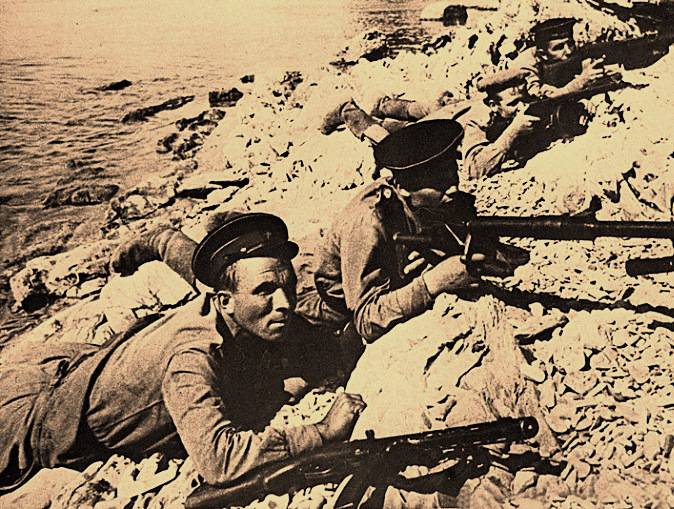
Of great importance in the implementation of the strategic plan for the capture of the Crimean peninsula was the Kerch-Eltigen landing operation. It began at night 1 on November 1943, landing an assault battalion of marines in the area of the Kamysh-Burun Cape. On November 3, the 318 Infantry Division landed at Enikale. For more than a month, the paratroopers, heroically repelling the attacks of the enemy, kept the bridgehead seized and ensured the deployment of the Separate Maritime Army, which made a significant contribution to the liberation of the Crimea. Thus, during the second period of the war for combat operations in the German rear was typical: an increase in the scope of the armed struggle, its duration and intensity, further improvement of the methods of actions of both airborne and naval assault forces.
In 1944-1945 The role of amphibious assault forces has increased. Thus, the Northern Fleet in 1944 during the Petsamo-Kirkenes operation in order to assist the 14 Army troops leading the offensive along the coast landed several assault forces. The largest was the Pechenga landing party as part of a special detachment (12 and 63 of the sea infantry brigades), landed from 12 to October 15 in the port of Linahamari.
Of great importance were the naval landings in the defeat of the fascists on the Karelian Isthmus, on the islands and the coast of the Baltic Sea. Especially instructive were the amphibious operations to liberate the Bjorksky and Moonsund archipelagoes in the summer and autumn of the year 1944. They involved naval infantry, rifle formations, a significant number of warships, as well as airborne assault vehicles, including amphibians. They were carried out, as usual, in close cooperation with ground troops, who were conducting an offensive along the coast. Amphibious landings successfully coped with their tasks, in April 1945 of the year landed on Frisch Nehrung's braid (two landings). Marine assault forces were also used during the battles for the liberation of the western coast of the Black Sea. The paratroopers were occupied by the cities of Tulcea, Sulin, Constanta, Varna, Burgas.
The experience gained in the use of airborne troops in the Patriotic War was widely used in the Far East during the defeat of the Japanese troops. From 16.08.1945 to 27.08.1945, it was planted in the central Manchurian cities, on the Liaodong Peninsula, in North Korea, on South Sakhalin and the Kuril Islands to master the strategic points, military and important industrial facilities located in the deep Japanese rear. about 20 landings numbering from 35-40 to 500-600 people. Airborne assault forces landed in Harbin, Changchun, Mukden, Jilin, Port Arthur, Pyongyang, and Tayokhar.
The wide scale of the use of airborne assault forces during the combat operations of our troops in the Far East is well demonstrated by the fact that the military transport aviation of three fronts performed 20% of 7650 sorties to ensure the transfer of airborne assault forces. In total, 17000 people were transported by air and about 6000 tons of various cargoes were transported. All landing parties successfully completed the task.
In the Far East, amphibious assault forces landed in the North Korean ports of Yuki, Racine, Seisin, Denak and Genzan, on South Sakhalin and the northern islands of the Kuril chain. For the transportation of troops there were used both small warships and transport ships, as well as special landing ships.
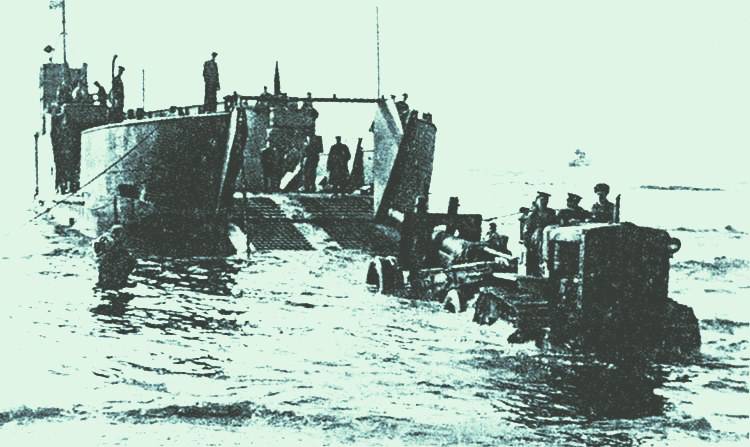
In the period under review, torpedo boats were often used for the first throw. After the landing, supported by artillery fire and air strikes, active offensive actions were widely used (the 12-I and 63-I naval brigades during the battles for the Pechenga and the 206-I naval brigade at the capture of the Moonzun archipelago).
Thus, at the last stage of the war, the volume of combat missions that were being solved by airborne and maritime landing forces increased. The strikes were dealt with even more closely with our advancing forces and had a significant role in completing the defeat of Germany and Japan.
Sources:
Gaevsky A. Parachutists of the Soviet fleet: the experience of creating and using parachute units of the Soviet Navy. 1941 - 1944 years. // Saboteurs of the Second World War. M .: Yauza, 2008. C. 23-32.
Vasilyev A. Maritime amphibious forces. M .: Voenizdat, 1971. C. 14-42.
Sofronov G. Airborne assault forces in the Second World War. M .: Voenizdat, 1962. C. 18-32, 56-72, 112-138.
Tsvetkov A. Fighting air and sea landing. // visage 1973. No.8. C. 20-26
Muzrukov E. Winners: Landing on the Dnieper // Brother. 2013. No.8. C. 36-42.
Information